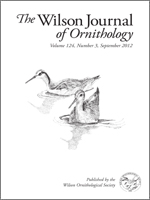Monk Parakeets (Myiopsitta monachus) have been in Florida for >40 yrs, having been imported by the thousands for the pet trade. This conspicuous, charismatic species is now widely established, but relatively little is known about its population biology outside South America. We examined 845 parakeets from 385 nests from nest removals and collections by utility company personnel in 2003/2004 and 2006/2007 to document body size and aspects of reproductive biology and primary molt. Body measurements confirm Monk Parakeets in south Florida belong to the monachus subspecies. Adult males averaged 1.5 to 3.5% larger than females, but the body mass of females exceeded that of males during March–May, the period of egg development. The breeding season in south Florida commences in late winter/early spring with fledglings first appearing in the second week of June. Nest contents (eggs plus nestlings) averaged 5.6 for multiple-entry nests compared to 4.9 for single-entry nests. Over 94% of the adults we examined were replacing primary feathers during June–August. The extent and timing of breeding and molt in south Florida are virtually identical to those in South America, although offset by ∼6 months. Monk Parakeets in south Florida retain a fixed annual cycle characteristic of the ancestral population, but their flexible behavior enables them to adapt and thrive in new environments.
How to translate text using browser tools
1 September 2012
Biology of Invasive Monk Parakeets in South Florida
Michael L. Avery,
Eric A. Tillman,
Kandy L. Keacher,
John E. Arnett,
Kelli J. Lundy
ACCESS THE FULL ARTICLE





